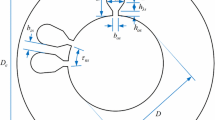Abstract
In this chapter a three-phase magnetic induction motor squirrel-cage is analyzed with the Finite Element Method (FEM). Five variations of the rotor geometry design are analyzed. The analysis has been made with simulations of static configurations. For each geometry an identification of the parametric model has been obtained. For the optimization of the parameters, Genetic Algorithms (GA) have been used as a robust optimization method.
Access this chapter
Tax calculation will be finalised at checkout
Purchases are for personal use only
Preview
Unable to display preview. Download preview PDF.
Similar content being viewed by others
References
Amuliu, B., Ali, K.: Identification of Variable Frequency Induction Motor Models From Operating Data. IEEE Transactions on Energy Conversion 17(1), 24–31 (2002)
Belmans, R., Findlay, R.D., Geysen, W.: A Circuit Approach to Finite Element Analysis of a Double Squirrel Cage Induction Motor. IEEE Transactions on Energy Conversion 5(4), 719–724 (1990)
Boonruang, M., Nittaya, M., Anant, O.: Dynamic Model Identification of Induction Motors using Intelligent Search Techniques with taking Core Loss into Account. In: 6th WSEAS International Conference on Power Systems, Lisbon, Portugal, pp. 108–115 (2006)
David, A., Gary, B.: Evolutionary Computation and Convergence to a Pareto Front, pp. 221–228. Stanford University, California (1998)
Haque, T., Nolan, R., Pillay, P., et al.: Parameter Determination for Induction Motors, pp. 45–49. IEEE, Los Alamitos (1994)
Harry, H., Charles, W.: Estimation of Induction Motor Parameters by Genetic Algorithm, pp. 21–28. IEEE, Los Alamitos (2003)
Lowther, D.A., Freeman, E.M.: Further aspects of the Kelvin transformation method for dealing with open boundaries. IEEE Transactions on Magnetics 28(2), 1667–1670
von Lücken, C.D.: Algoritmos Evolutivos para Optimización Multiobjetivo: un Estudio Comparativo en un Ambiente Paralelo Asíncrono. Universidad Nacional de Asunción (2003)
Meeker, D.: Induction Motor Example. IEEE, Los Alamitos (2002)
Mehmet, Ç., Ramazan, A.: Design optimization of induction motor by genetic algorithm and comparison with existing motor. Mathematical and Computational Applications 11(3), 193–203 (2006)
Mehmet, Ç., Ramazan, A., Osman, B.: Cost optimization of submersible motors using a genetic algorithm and a finite element method. Int. J. Adv. Manuf. Technol. 33, 223–232 (2006)
Mirafzal, B., Gary, L., Rangarajan, M.: Determination of Parameters in the Universal Induction Motor Model. IEEE Transaction on Industry Applications 45(1), 1207–1216 (2007)
Molinar, D., De Weerdt, R., Belmans, R., et al.: Calculation of two-axis induction motor model parameters using finite elements. IEEE, Los Alamitos (1996)
Nerg, J., Pyrhonen, J., Partanen, J.: Finite element modelling of the magnetizing inductance of an induction motor as a function of torque. IEEE Transactions on M 40(4), 2047–2049 (2004)
Patrick, N., Anahita, Z., El-Sharkawi, M.A.: Pareto Multi Objective Optimization, pp. 84–91. IEEE, Los Alamitos (2005)
Phumiphak, T., Chat-Uthai, C.: Estimation of Induction Motor Parameters Based on Field Test Coupled with Genetic Algorithm, pp. 1199–1203. IEEE, Los Alamitos (2002)
Qiushi, C., Adalbert, K.: A Review of Finite Element Open Boundary Techniques for Static and Quasi-Static Electromagnetic Field Problems. IEEE Transactions on Magnetics 33(1), 663–676 (1997)
Rasmus, K.U.: Models for Evolutionary Algoritms and Their Applications in System Identification and Control Optimization. University of Aarhus (2003)
Rasmus, K., Pierré, V.: Parameter identification of induction motors using stochastic optimization algorithms. Applied Soft. Computing 4, 49–64 (2004), doi:10.1016/j.asoc.2003.08.002
Salon, S.J.: Finite Element Analysis of Electrical Machines. Kluwer Academic Publishers, Boston (1995)
Stochniol, A.: A General Transformation for Open Boundary Finite Element Method for Electromagnetic Problems. IEEE Transactions on Magnetics 28(2), 1679–1681 (1992)
Tandom, S.C.: Finite Element Analysis of Induction Machines. IEEE, Los Alamitos (1982)
Wall, M.: GAlib documentation. MIT, Cambridge (2000), http://lancet.mit.edu/ga/dist/
Yamazaki, K.: An efficient procedure to calculate equivalent circuit parameters of induction motor using 3-D nonlinear time-stepping finite-element method. IEEE Transactions on Magnetics 38(2), 1281–1284 (2002)
Yann, C.: Personal Website (2009), http://ycollette.free.fr
Author information
Authors and Affiliations
Editor information
Editors and Affiliations
Rights and permissions
Copyright information
© 2010 Springer-Verlag Berlin Heidelberg
About this chapter
Cite this chapter
Simón, L., Monzón, J.M. (2010). Parametric Identification of a Three-Phase Machine with Genetic Algorithms. In: Wiak, S., Napieralska-Juszczak, E. (eds) Computational Methods for the Innovative Design of Electrical Devices. Studies in Computational Intelligence, vol 327. Springer, Berlin, Heidelberg. https://doi.org/10.1007/978-3-642-16225-1_9
Download citation
DOI: https://doi.org/10.1007/978-3-642-16225-1_9
Publisher Name: Springer, Berlin, Heidelberg
Print ISBN: 978-3-642-16224-4
Online ISBN: 978-3-642-16225-1
eBook Packages: EngineeringEngineering (R0)




